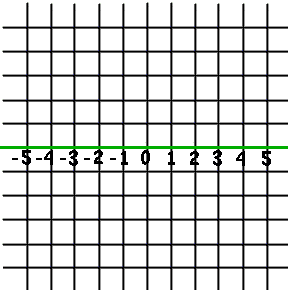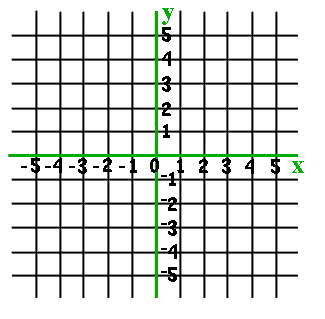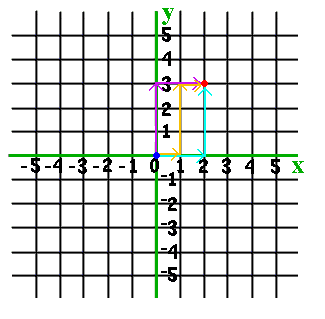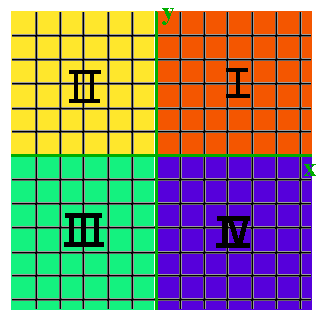|
Mentor: Please, draw a straight horizontal line at the center of your graphing paper. As we count: "Zero, one, two, three.." we put the numbers on the line, one number per line of the graph paper. When we count backwards, we distinguish the numbers that come before zero by placing a "-" sign in front of them, so it goes: "Two, one, zero..." Make sure that you evenly space the numbers, since the distance from 1 to 2 should be the same as the distance from 2 to 3.
 Student: Minus one, minus two, minus three... Mentor: What we have now is called a "number line" or "coordinate line." It can be used to describe where a point is on the line. To give the exact "address" of a point, we just look at how far the point is from zero, using a minus sign for numbers to the left of zero. Student: So the address of this point (Student highlights 4) is 4, and the address of this point (Student highlights -5) is -5. Mentor: Now we want to get more freedom of movement. We will let our points be anywhere on the paper, not only on the line. To give an address for the points that are not on the number line we will need to make a vertical number line. Draw a vertical line through the zero of the horizontal number line. Now label it with positive numbers above the horizontal number line and the negative numbers below the horizontal number line. Instead of saying horizontal number line and vertical number line all the time let's call them by their official name. The horizontal number line is called the x-axis and the vertical number line is y-axis.

We still count from zero, but now we will need more than just one number to give the exact "address" of a point. For example, can you describe how to get to this point (Mentor highlights (2, 3) ) from zero? We can think about the grid as streets, and squares as blocks, so we are only allowed to go by the grid lines. Student: Well, I would go up three blocks and then right two blocks. Mentor: Sure. How else can we get there? Student: We can first go two blocks to the right, and then three blocks up.

Student: Or we can go one right, three up, and one more right. Mentor: There are many ways to get from one point to another point (how many ways, by the way?). To create a standard way of referring to points, scientists came to an agreement that they will always name the point after one special way of walking. As usual, starting from zero, we go all the way to the right or to the left, counting steps: one, two. Then we go up or down: one, two three steps up. Then we write the number of steps like that: (2,3). Again, the first number is "left-right," the second "up-down." A minus sign means either left or down. So, if our point is (-2, -3), we go two steps to the left, and then three steps down. Do you remember the names of our number lines? Student: Yes, they are called the x-axis and the y-axis. Mentor: Can any one think of a better way to describe the address of a point instead of (left-right, up-down)? Student: Could we call the address by the names of the lines? Mentor: Yes, so the address of a point would be described as (x,y) instead of (left-right, up-down). The mathematical term for the address of a point is called coordinates. Now does everyone see how the x-axis and y-axis divide our paper into four sections?

Student: Yes and I bet they have names too! Mentor: You are right! These sections are called quadrants. Student: Are they called quadrants because there are four of them and there are four sides to a quadralateral? Mentor: Very good! We get our prefix "quad" from the Latin word "quattuor" which means four. Each of these quadrants is identified by a number.
Student: Will any point that has an address of (positive, negative) be in the fourth quadrant? Mentor: Yes, but let's use the correct vocabulary. Any point that has coordinates of (positive, negative) is in the fourth quadrant. Student: Now we can play the maze game!

Please direct questions and comments about this project to Addison-Wesley math@aw.com © Copyright 1997-2001 The Shodor Education Foundation, Inc. © Copyright 2001 Addison-Wesley. All rights reserved. |